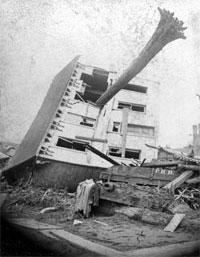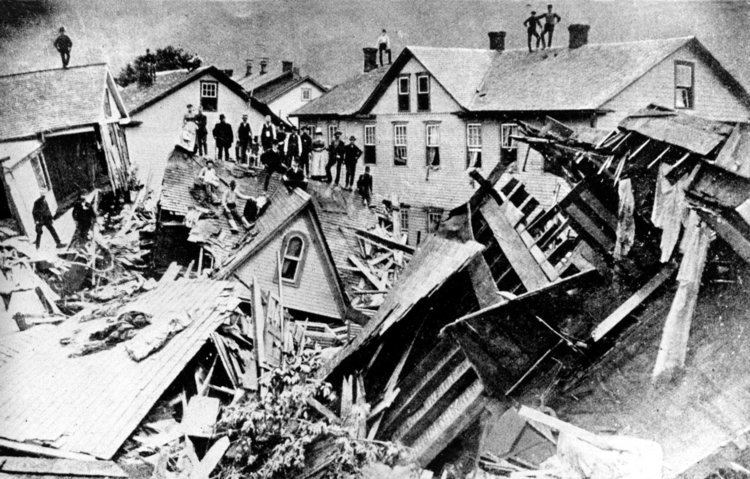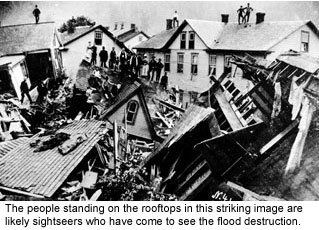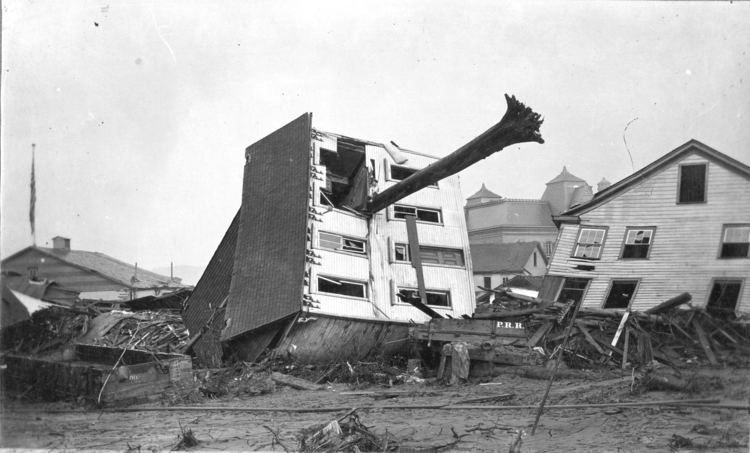Property damage US$17 million Total number of deaths 2,209 | Date 31 May 1889 | |
 | ||
Similar Pittsburgh flood of 1936, 1906 San Francisco earthquake, Great Mississippi Flood of 1, Peshtigo Fire, Buffalo Creek flood | ||
Remembering the 1977 johnstown flood
The Johnstown Flood (locally, the Great Flood of 1889) occurred on May 31, 1889, after the catastrophic failure of the South Fork Dam on the Little Conemaugh River 14 miles (23 km) upstream of the town of Johnstown, Pennsylvania. The dam broke after several days of extremely heavy rainfall, releasing 14.55 million cubic meters of water (16 million US tons) from the reservoir known as Lake Conemaugh. With a volumetric flow rate that temporarily equaled that of the Mississippi River, the flood killed 2,209 people and caused US$17 million of damage (about $450 million in 2015 dollars).
Contents
- Remembering the 1977 johnstown flood
- History
- South Fork Dam and Lake Conemaugh
- Events of the flood
- Immediately afterward
- Subsequent floods
- Court case and recovery
- Investigation of the cause of the 1889 dam breach and flood
- Effect on the development of American law
- Legacy and popular culture
- Science fiction
- Film and television
- Theater
- Music
- Literature
- References

The American Red Cross, led by Clara Barton and with 50 volunteers, undertook a major disaster relief effort. Support for victims came from all over the United States and 18 foreign countries. After the flood, survivors suffered a series of legal defeats in their attempts to recover damages from the dam's owners. Public indignation at that failure prompted the development in American law changing a fault-based regime to strict liability.

History

The village of Johnstown was founded in 1800 by the Swiss immigrant Joseph Johns (anglicized from "Schantz") where the Stony Creek and Little Conemaugh rivers joined to form the Conemaugh River. It began to prosper with the building of the Pennsylvania Main Line Canal in 1836 and the construction in the 1850s of the Pennsylvania Railroad and the Cambria Iron Works. By 1889, Johnstown's industries had attracted numerous Welsh and German immigrants. With a population of 30,000, it was a growing industrial community known for the quality of its steel.

The high, steep hills of the narrow Conemaugh Valley and the Allegheny Mountains range to the east kept development close to the riverfront areas. The valley had large amounts of runoff from rain and snowfall. The area surrounding Johnstown is prone to flooding due to its location on the rivers, whose upstream watersheds include an extensive drainage basin of the Allegheny plateau. Adding to these factors, slag from the iron furnaces of the steel mills was dumped along the river to create more land for building. Developers' artificial narrowing of the riverbed to maximize early industries left the city even more flood-prone. The Conemaugh River immediately downstream of Johnstown is hemmed in by steep mountainsides for about 10 miles (16 km).
South Fork Dam and Lake Conemaugh
High above the city, the Commonwealth of Pennsylvania built the South Fork Dam between 1838 and 1853, as part of a cross-state canal system, the Main Line of Public Works. Johnstown was the eastern terminus of the Western Division Canal, supplied with water by Lake Conemaugh, the reservoir behind the dam. As railroads superseded canal barge transport, the Commonwealth abandoned the canal and sold it to the Pennsylvania Railroad. The dam and lake were part of the purchase, and the railroad sold them to private interests.
Henry Clay Frick led a group of speculators, including Benjamin Ruff, from Pittsburgh to purchase the abandoned reservoir, modify it, and convert it into a private resort lake for their wealthy associates. Many were connected through business and social links to Carnegie Steel. Development included lowering the dam to make its top wide enough to hold a road, and putting a fish screen in the spillway (the screen also trapped debris). These alterations are thought to have increased the vulnerability of the dam. Moreover, a system of relief pipes and valves, a feature of the original dam, previously sold off for scrap, was not replaced, so the club had no way of lowering the water level in the lake in case of an emergency. The members built cottages and a clubhouse to create the South Fork Fishing and Hunting Club, an exclusive and private mountain retreat. Membership grew to include more than 50 wealthy Pittsburgh steel, coal, and railroad industrialists.
Lake Conemaugh at the club's site was 450 feet (140 m) in elevation above Johnstown. The lake was about 2 miles (3.2 km) long, about 1 mile (1.6 km) wide, and 60 feet (18 m) deep near the dam.
The dam was 72 feet (22 m) high and 931 feet (284 m) long. After 1881, when the club opened, the dam frequently sprang leaks. It was patched, mostly with mud and straw. There had been some speculation as to the dam's integrity, and concerns had been raised by the head of the Cambria Iron Works downstream in Johnstown.
Events of the flood
On May 28, 1889, a storm formed over Nebraska and Kansas and headed east. When the storm struck the Johnstown-South Fork area two days later, it was the worst downpour that had ever been recorded in that part of the country. The U.S. Army Signal Corps estimated that 6 to 10 inches (150 to 250 mm) of rain fell in 24 hours over the region. During the night, small creeks became roaring torrents, ripping out trees and debris. Telegraph lines were downed and rail lines were washed away. Before daybreak, the Conemaugh River that ran through Johnstown was about to overwhelm its banks.
On the morning of May 31, in a farmhouse on a hill just above the South Fork Dam, Elias Unger, president of the South Fork Fishing and Hunting Club, awoke to the sight of Lake Conemaugh swollen after a night-long heavy rainfall. Unger ran outside in the still-pouring rain to assess the situation and saw that the water was nearly cresting the dam. He quickly assembled a group of men to save the face of the dam by trying to unclog the spillway; it was blocked by the broken fish trap and debris caused by the swollen waterline. Other men tried digging a ditch at the other end of the dam, on the western abutment which was lower than the dam crest. The idea was to let more water out of the lake to try to prevent overtopping of the crest, but without success. Most remained on top of the dam, some plowing earth to raise it, while others tried to pile mud and rock on the face to save the eroding wall.
John Parke, an engineer for the South Fork Club, briefly considered cutting through the dam's end, where the pressure would be less, but decided against it as that would have ensured failure of the dam. Twice, under orders from Unger, Parke rode on horseback to the nearby town of South Fork to the telegraph office to send warnings to Johnstown explaining the critical nature of the eroding dam. But the warnings were not passed to the authorities in town, as there had been many false alarms in the past of the South Fork Dam not holding against flooding. Unger, Parke, and the rest of the men continued working until exhausted to save the face of the dam; they abandoned their efforts at around 1:30 p.m., fearing that their efforts were futile and the dam was at risk of imminent collapse. Unger ordered all of his men to fall back to high ground on both sides of the dam where they could do nothing but wait. During the day in Johnstown, the situation worsened as water rose to as high as 10 feet (3.0 m) in the streets, trapping some people in their houses.
Between 2:50 and 2:55 p.m. the South Fork Dam breached. A LiDAR analysis of the Conemaugh Lake basin reveals that it contained 14.55 million cubic meters of water at the moment the dam collapsed. Dam-breach modeling reveals that it took at least 65 minutes for most of the lake to drain after the dam failed. The first town to be hit by the flood was South Fork. The town was on high ground, and most of the people escaped by running up the nearby hills when they saw the dam spill over. Some 20 to 30 houses were destroyed or washed away, and four people were killed.
On its way downstream to Johnstown, 14 miles (23 km) away, the crest picked up debris, such as trees, houses, and animals. At the Conemaugh Viaduct, a 78-foot (24 m) high railroad bridge, the flood temporarily was stopped when debris jammed against the stone bridge's arch. But within seven minutes, the viaduct collapsed, allowing the flood to resume its course. Because of this, the surging river gained renewed hydraulic head, resulting in a stronger wave hitting Johnstown than otherwise would have been expected. The small town of Mineral Point, one mile (1.6 km) below the Conemaugh Viaduct, was hit with this renewed force. About 30 families lived on the village's single street. After the flood, only bare rock remained. About 16 people were killed. In 2009, studies showed that the flood's flow rate through the narrow valley exceeded 420,000 cubic feet per second (12,000 m3/s), comparable to the flow of the Mississippi River, which varies between 250,000 and 710,000 cu ft/s (7,000 and 20,000 m3/s).
The village of East Conemaugh was next. One witness on high ground near the town described the water as almost obscured by debris, resembling "a huge hill rolling over and over". From his idle locomotive in the town's railyard, the engineer John Hess heard and felt the rumbling of the approaching flood. Throwing his locomotive into reverse, Hess raced backward toward East Conemaugh, the whistle blowing constantly. His warning saved many people who reached high ground. When the flood hit, it picked up the locomotive and tossed it aside; Hess himself survived, but at least 50 people died, including about 25 passengers stranded on trains in the town.
Before hitting the main part of Johnstown, the flood surge hit the Cambria Iron Works at the town of Woodvale, sweeping up railroad cars and barbed wire in its moil. Of Woodvale's 1,100 residents, 314 died in the flood. Boilers exploded when the flood hit the Gautier Wire Works, causing black smoke seen by the Johnstown residents. Miles of its barbed wire became entangled in the debris in the flood waters.
Some 57 minutes after the South Fork Dam collapsed, the flood hit Johnstown. The residents were caught by surprise as the wall of water and debris bore down, traveling at 40 miles per hour (64 km/h) and reaching a height of 60 feet (18 m) in places. Some people, realizing the danger, tried to escape by running towards high ground but most people were hit by the surging floodwater. Many people were crushed by pieces of debris, and others became caught in barbed wire from the wire factory upstream and/or drowned. Those who reached attics, or managed to stay afloat on pieces of floating debris, waited hours for help to arrive.
At Johnstown, the Stone Bridge, which was a substantial arched structure, carried the Pennsylvania Railroad across the Conemaugh River. The debris carried by the flood formed a temporary dam at the bridge, resulting in the flood surge rolling upstream along the Stoney Creek River. Eventually, gravity caused the surge to return to the dam, causing a second wave to hit the city, but from a different direction. Some people who had been washed downstream became trapped in an inferno as the debris piled up against the Stone Bridge caught fire; at least 80 people died there. The fire at the Stone Bridge burned for three days. After floodwaters receded, the pile of debris at the bridge was seen to cover 30 acres (12 ha), and reached 70 feet (21 m) in height. It took workers three months to remove the mass of debris, largely because it was bound by the steel wire from the ironworks. Dynamite was eventually used to clear it. Still standing and in use as a railroad bridge, the Stone Bridge is a landmark associated with survival and recovery from the flood. In 2008, it was restored in a project including new lighting as part of commemorative activities related to the flood.
Immediately afterward
The total death toll was 2,209, making the disaster the largest loss of civilian life in the United States at the time (perhaps with exception of the Peshtigo Fire). The number of deaths from the 1889 flood was later surpassed by fatalities in the 1900 Galveston hurricane and the September 11, 2001 terrorist attacks. However, as pointed out by David McCullough in 1968 (pages 266 and 278), a man reported as presumed dead (not known to have been found) had survived. In 1900, Leroy Temple showed up in Johnstown to confess he had not died but had extricated himself from the flood debris at the stone bridge below Johnstown and walked out of the valley. Until 1900 Temple had been living in Beverly, Massachusetts. Therefore the official death toll from the 1889 flood must be reduced to 2208.
Ninety-nine entire families died in the flood, including 396 children. One hundred twenty-four women and 198 men were widowed, 98 children were orphaned. One-third of the dead, 777 people, were never identified; their remains were buried in the "Plot of the Unknown" in Grandview Cemetery in Westmont.
It was the worst flood to hit the U.S. in the 19th century. Sixteen hundred homes were destroyed, $17 million in property damage levied, and 4 square miles (10 km2) of downtown Johnstown were completely destroyed. Clean-up operations continued for years. Although Cambria Iron and Steel's facilities were heavily damaged, they returned to full production within a year and a half.
Working seven days and nights, workmen built a wooden trestle bridge to temporarily replace the huge stone railroad viaduct, which had been destroyed by the flood. The Pennsylvania Railroad restored service to Pittsburgh, 55 miles (89 km) away, by June 2. Food, clothing, medicine, and other provisions began arriving by rail. Morticians traveled by railroad. Johnstown's first call for help requested coffins and undertakers. The demolition expert "Dynamite Bill" Flinn and his 900-man crew cleared the wreckage at the Stone Bridge. They carted off debris, distributed food, and erected temporary housing. At its peak, the army of relief workers totaled about 7,000.
One of the first outsiders to arrive was Clara Barton, nurse, founder and president of the American Red Cross. Barton arrived on June 5, 1889, to lead the group's first major disaster relief effort; she did not leave for more than 5 months. She and many other volunteers worked tirelessly. Donations for the relief effort came from all over the United States and overseas. $3,742,818.78 was collected for the Johnstown relief effort from within the U.S. and 18 foreign countries, including Russia, Turkey, France, Great Britain, Australia, and Germany.
Frank Shomo, the last known survivor of the 1889 flood, died March 20, 1997, at the age of 108.
Subsequent floods
Floods have continued to be a concern for Johnstown, which had major flooding in 1894, 1907, and 1924. The biggest flood of the first half of the 20th century was the St. Patrick's Day Flood of March 1936. It also reached Pittsburgh, where it was known as the Great Pittsburgh Flood of 1936. Following the 1936 flood, the U.S. Army Corps of Engineers dredged the river within the city and built concrete river walls, creating a channel nearly 20 feet deep. Upon completion, the Corps proclaimed Johnstown "flood free."
The new river walls withstood Hurricane Agnes in 1972, but on the night of July 19, 1977, a severe thunderstorm dropped 11 inches of rain in eight hours on the watershed above the city and the rivers began to rise. By dawn, the city was under water that reached as high as 8 feet (2.4 m). Seven counties were declared a disaster area, suffering $200 million in property damage, and 78 people died. Forty were killed by the Laurel Run Dam failure. Another 50,000 were rendered homeless as a result of this "100-year flood". Markers on a corner of City Hall at 401 Main Street show the height of the crests of the 1889, 1936, and 1977 floods.
Court case and recovery
In the years following the disaster, some people blamed the members of the South Fork Fishing and Hunting Club for their modifications to the dam and failure to maintain it properly. The club had bought and redesigned the dam to turn the area into a vacation retreat in the mountains. They were accused of failing to maintain the dam properly, so that it was unable to contain the additional water of the unusually heavy rainfall.
Popular feeling ran high and was best summed up in the concluding lines of Isaac Reed's poem:
The club was successfully defended by the firm of Knox and Reed (now Reed Smith LLP), whose partners Philander Knox and James Hay Reed were both Club members. The Club was never held legally responsible for the disaster. The court held the dam break to have been an Act of God, and granted the survivors no legal compensation.
Individual members of the club, millionaires in their day, contributed to the recovery. Along with about half of the club members, Henry Clay Frick donated thousands of dollars to the relief effort in Johnstown. After the flood, Andrew Carnegie, already known as an industrialist and philanthropist, built the town a new library.
Investigation of the cause of the 1889 dam breach and flood
On June 5th, 1889, just five days after the dam breach flood, the American Society of Civil Engineers (ASCE) appointed a committee of four prominent engineers to investigate the cause of the disaster. This committee was led by the esteemed James B. Francis, a hydraulic engineer best known for his work related to canals, flood control, turbine design, dam construction, and hydraulic calculations. Francis was a founding member of the ASCE and served as its president from November 1880 to January of 1882. The ASCE committee visited the South Fork dam, reviewed the original engineering design of the dam and modifications made during repairs, interviewed eyewitnesses, commissioned a topographic survey of the dam remnants, and performed hydrologic calculations. In their final report they concluded the South Fork dam would have failed even if it had been maintained within the original design specifications, i.e., with a higher embankment crest and with five large discharge pipes at the dam’s base. This claim by the ASCE committee has now been challenged.
The ASCE committee completed their investigation report on January 15th, 1890, but the report was sealed and not shared with other ASCE members or the public. At ASCE’s annual convention in June of 1890, committee member Max Becker was quoted as saying “We will hardly [publish our investigation] report this session, unless pressed to do so, as we do not want to become involved in any any litigation”. Although many ASCE members clamored for the report, it was not published in the society’s transactions until two years after the disaster, in June 1891.
A hydraulic analysis published in 2016 confirms what had long been suspected, that the changes made to the dam by the South Fork Fishing and Hunting Club severely reduced the ability of the dam to withstand major storms. Lowering the dam by as much as 0.9 meter (3 ft) and failing to replace the discharge pipes at the base of the dam cut in half the safe discharge capacity of the dam. This fatal lowering of the dam greatly reduced the capacity of the main spillway and virtually eliminated the action of an emergency spillway on the western abutment. Walter Frank first documented the presence of that emergency spillway in a 1988 ASCE publication. The existence of the emergency spillway is supported by topographic data from 1889 which shows the western abutment to be about one foot lower than the crest of the dam remnants, even after the dam had previously been lowered as much as 3 feet by the South Fork Fishing and Hunting Club. Adding the width of the emergency spillway to that of the main spillway yields the total width of spillway (wasteway) capacity that had been specified in the 1847 design of William Morris, a State Engineer. However, lowering the top of the dam by the Club eliminated nearly all of the capacity of the emergency spillway and greatly reduced the discharge capacity of the main spillway on the eastern side. The dam was now vulnerable to large storm events and was unable to survive the May, 1889 storm.
Effect on the development of American law
Survivors were unable to recover damages in court because of the club's ample resources. First, the wealthy club owners had designed the club's financial structure to keep their personal assets separated from it and, secondly, it was difficult for any suit to prove that any particular owner had behaved negligently. Though the former reason was probably more central to the failure of survivors' suits against the club, the latter received coverage and extensive criticism in the national press.
As a result of this criticism, in the 1890s, state courts around the country adopted Rylands v. Fletcher, a British common-law precedent which had formerly been largely ignored in the United States. State courts' adoption of Rylands, which held that a non-negligent defendant could be held liable for damage caused by the unnatural use of land, foreshadowed the legal system's 20th-century acceptance of strict liability.
Legacy and popular culture
At Point Park in Johnstown, at the confluence of the Stonycreek and Little Conemaugh rivers, an eternal flame burns in memory of the flood victims.
The Carnegie Library is now owned by the Johnstown Historical Society, which has adapted it for use as The Flood Museum.
Portions of the Stone Bridge have been made part of the Johnstown Flood National Memorial, established in 1969 and managed by the National Park Service.
The flood has been the subject or setting for numerous histories, novels, and other works as well.
Science fiction
Film and television
Theater
Music
Literature
There is literature about the flood. Poems include:
Short stories include:
Books about the flood in a historical context include:
Fictional novels include:
